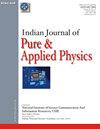Identification of Potential Dipeptide Inhibitors for PfENR Enzyme in Fatty Acid Biosynthesis Pathway II: A Computational Study for Developing Novel Antimalarials
IF 1.1
4区 物理与天体物理
Q4 PHYSICS, MULTIDISCIPLINARY
引用次数: 0
Abstract
Malaria is a life-threatening disease caused by parasites of the genus Plasmodium that are transmitted through the bite of infected female Anopheles mosquitoes. The essential role of fatty acids in the malarial parasite's liver and blood stages makes it a promising target for combating P. falciparum. However, the emergence of strains of the malarial parasite has limited the efficacy of currently available drugs against malaria. Therefore, there is an urgent need to develop new drugs that can target the parasite and overcome drug resistance. This study aimed to identify potential dipeptide inhibitors for the PfENR enzyme using in-silico methods. Virtual screening was performed using thelibrary of 400 dipeptides to identify lead dipeptides with an affinity towards PfENR. We observed dipeptides Trp-Trp, Trp-Phe, Trp-Tyr, Tyr-Phe are showing the best affinity against PfENR. Density Functional Theory (DFT) analysis was used to reveal the electronic structure and reactivity of the top dipeptides by calculating the HOMO-LUMO gap. Additionally, we assessed the pharmacokinetic and other relevant properties of the lead dipeptides. All the lead dipeptides followed Lipinski's rule of five (Ro5). Our findings suggest that the identified dipeptides have significant potential as inhibitors of PfENR and could lead to the development of a novel class of antimalarial drugs. This research provides valuable insights into developing effective drugs to combat malaria.脂肪酸生物合成途径中PfENR酶潜在二肽抑制剂的鉴定:开发新型抗疟药物的计算研究
疟疾是一种威胁生命的疾病,由疟原虫属寄生虫引起,通过受感染的雌性按蚊叮咬传播。脂肪酸在疟原虫肝脏和血液阶段的重要作用使其成为对抗恶性疟原虫的一个有希望的目标。然而,疟疾寄生虫菌株的出现限制了目前可用的抗疟疾药物的效力。因此,迫切需要开发针对寄生虫并克服耐药性的新药。本研究旨在利用计算机方法鉴定PfENR酶的潜在二肽抑制剂。利用400个二肽库进行虚拟筛选,以鉴定与PfENR有亲和力的铅二肽。我们观察到二肽Trp-Trp、Trp-Phe、Trp-Tyr、Tyr-Phe对PfENR的亲和力最好。利用密度泛函理论(DFT)计算HOMO-LUMO间隙,揭示了顶端二肽的电子结构和反应性。此外,我们评估了铅二肽的药代动力学和其他相关性质。所有的二肽都遵循利平斯基的五法则(Ro5)。我们的研究结果表明,鉴定的二肽具有作为PfENR抑制剂的巨大潜力,并可能导致开发一类新的抗疟疾药物。这项研究为开发对抗疟疾的有效药物提供了有价值的见解。
本文章由计算机程序翻译,如有差异,请以英文原文为准。
求助全文
约1分钟内获得全文
求助全文
来源期刊
CiteScore
1.30
自引率
14.30%
发文量
42
审稿时长
7 months
期刊介绍:
Started in 1963, this journal publishes Original Research Contribution as full papers, notes and reviews on classical and quantum physics, relativity and gravitation; statistical physics and thermodynamics; specific instrumentation and techniques of general use in physics, elementary particles and fields, nuclear physics, atomic and molecular physics, fundamental area of phenomenology, optics, acoustics and fluid dynamics, plasmas and electric discharges, condensed matter-structural, mechanical and thermal properties, electronic, structure, electrical, magnetic and optical properties, cross-disciplinary physics and related areas of science and technology, geophysics, astrophysics and astronomy. It also includes latest findings in the subject under News Scan.

 求助内容:
求助内容: 应助结果提醒方式:
应助结果提醒方式:


